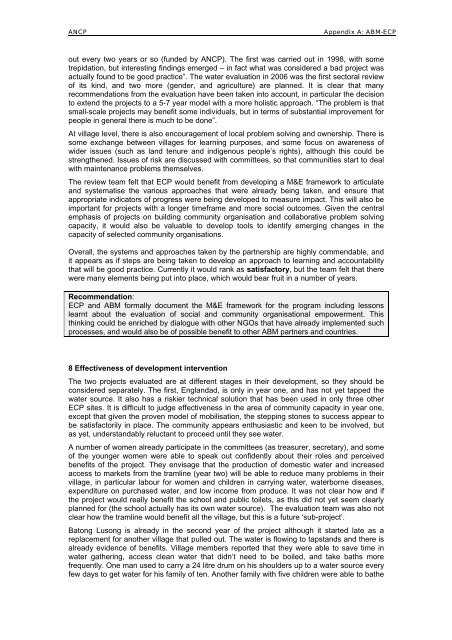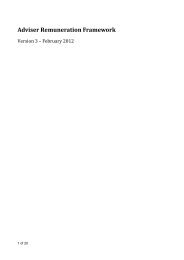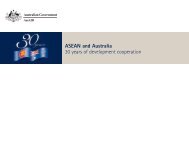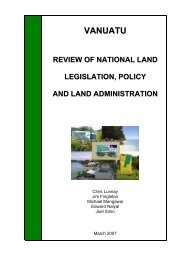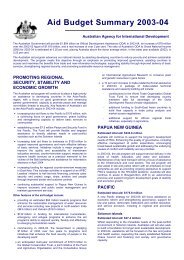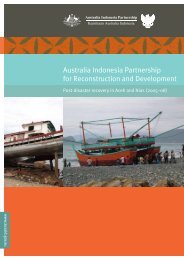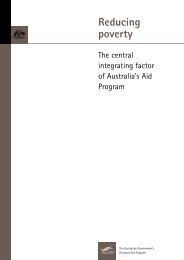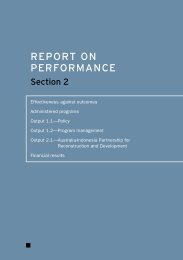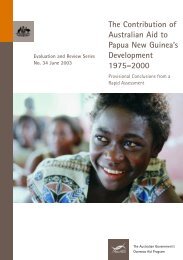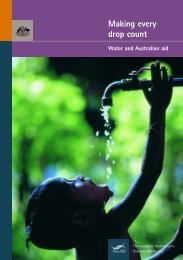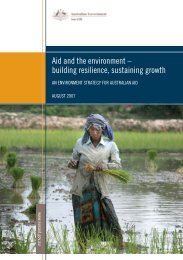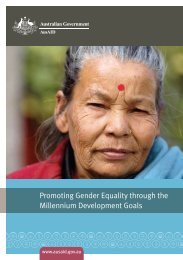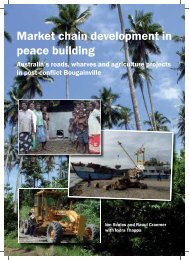ANCP Philippines Cluster Evaluation Report - AusAID
ANCP Philippines Cluster Evaluation Report - AusAID
ANCP Philippines Cluster Evaluation Report - AusAID
You also want an ePaper? Increase the reach of your titles
YUMPU automatically turns print PDFs into web optimized ePapers that Google loves.
<strong>ANCP</strong>Appendix A: ABM-ECPout every two years or so (funded by <strong>ANCP</strong>). The first was carried out in 1998, with sometrepidation, but interesting findings emerged – in fact what was considered a bad project wasactually found to be good practice”. The water evaluation in 2006 was the first sectoral reviewof its kind, and two more (gender, and agriculture) are planned. It is clear that manyrecommendations from the evaluation have been taken into account, in particular the decisionto extend the projects to a 5-7 year model with a more holistic approach. “The problem is thatsmall-scale projects may benefit some individuals, but in terms of substantial improvement forpeople in general there is much to be done”.At village level, there is also encouragement of local problem solving and ownership. There issome exchange between villages for learning purposes, and some focus on awareness ofwider issues (such as land tenure and indigenous people’s rights), although this could bestrengthened. Issues of risk are discussed with committees, so that communities start to dealwith maintenance problems themselves.The review team felt that ECP would benefit from developing a M&E framework to articulateand systematise the various approaches that were already being taken, and ensure thatappropriate indicators of progress were being developed to measure impact. This will also beimportant for projects with a longer timeframe and more social outcomes. Given the centralemphasis of projects on building community organisation and collaborative problem solvingcapacity, it would also be valuable to develop tools to identify emerging changes in thecapacity of selected community organisations.Overall, the systems and approaches taken by the partnership are highly commendable, andit appears as if steps are being taken to develop an approach to learning and accountabilitythat will be good practice. Currently it would rank as satisfactory, but the team felt that therewere many elements being put into place, which would bear fruit in a number of years.Recommendation:ECP and ABM formally document the M&E framework for the program including lessonslearnt about the evaluation of social and community organisational empowerment. Thisthinking could be enriched by dialogue with other NGOs that have already implemented suchprocesses, and would also be of possible benefit to other ABM partners and countries.8 Effectiveness of development interventionThe two projects evaluated are at different stages in their development, so they should beconsidered separately. The first, Englandad, is only in year one, and has not yet tapped thewater source. It also has a riskier technical solution that has been used in only three otherECP sites. It is difficult to judge effectiveness in the area of community capacity in year one,except that given the proven model of mobilisation, the stepping stones to success appear tobe satisfactorily in place. The community appears enthusiastic and keen to be involved, butas yet, understandably reluctant to proceed until they see water.A number of women already participate in the committees (as treasurer, secretary), and someof the younger women were able to speak out confidently about their roles and perceivedbenefits of the project. They envisage that the production of domestic water and increasedaccess to markets from the tramline (year two) will be able to reduce many problems in theirvillage, in particular labour for women and children in carrying water, waterborne diseases,expenditure on purchased water, and low income from produce. It was not clear how and ifthe project would really benefit the school and public toilets, as this did not yet seem clearlyplanned for (the school actually has its own water source). The evaluation team was also notclear how the tramline would benefit all the village, but this is a future ‘sub-project’.Batong Lusong is already in the second year of the project although it started late as areplacement for another village that pulled out. The water is flowing to tapstands and there isalready evidence of benefits. Village members reported that they were able to save time inwater gathering, access clean water that didn’t need to be boiled, and take baths morefrequently. One man used to carry a 24 litre drum on his shoulders up to a water source everyfew days to get water for his family of ten. Another family with five children were able to bathe<strong>ANCP</strong> <strong>Philippines</strong> <strong>Cluster</strong> <strong>Evaluation</strong> <strong>Report</strong> (ver. 2.0)IX


